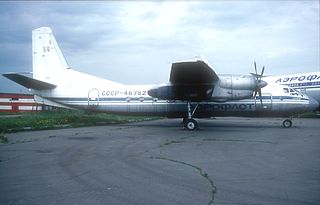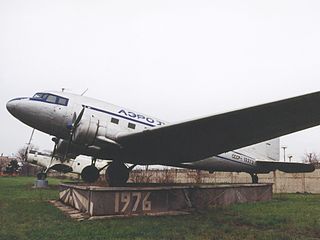
The Tenerife airport disaster occurred on 27 March 1977, when two Boeing 747 passenger jets collided on the runway at Los Rodeos Airport on the Spanish island of Tenerife. The collision occurred when KLM Flight 4805 initiated its takeoff run in dense fog while Pan Am Flight 1736 was still on the runway. The impact and the resulting fire killed all 248 people on board the KLM plane and 335 of the 396 people on board the Pan Am plane, with only 61 survivors in the front section of the latter aircraft. With a total of 583 fatalities, the disaster is the deadliest accident in aviation history.

Linjeflyg Flight 267V was a controlled flight into terrain by a Convair 440-75 Metropolitan on 20 November 1964 at 21:14 in Ängelholm, Skåne, Sweden. The Linjeflyg pilots, misled by a non-conventional military runway light configuration, descended too early and on a faulty course during approach to Ängelholm–Helsingborg Airport. The crash killed 31 of 43 people on board, making it the deadliest aviation accident in Sweden.
Aviaarktika was a Soviet airline which started operations on 1 September 1930 and was absorbed by Aeroflot on 3 January 1960.

Braathens SAFE Flight 253, also known as the Hummelfjell Accident, occurred on 7 November 1956 at 9:50, when a de Havilland Heron crashed into Hummelfjell mountain in Tolga, Norway. The Braathens SAFE aircraft was en route from Trondheim Airport, Værnes to Oslo Airport, Fornebu. While passing Røros, the Heron started experiencing a rapid atmospheric icing which soon was too extensive for the ice protection system to handle. Combined with a downdraft, the aircraft lost sufficient lift to stay airborne. The pilots were able to turn the aircraft around, but it nevertheless hit Hummelfjell at an altitude of 1,350 meters (4,430 ft) above mean sea level.

Aeroflot Flight 99 was a Tupolev Tu-124 operating a scheduled domestic passenger flight from Leningrad to Murmansk, both in the Soviet Union, which crashed while attempting to land on 11 November 1965. Of the 64 passengers and crew on board, 32 were killed in the accident, and many of the survivors sustained injuries.

Aeroflot Flight 191 was a Soviet domestic passenger flight from Vnukovo International Airport to Ashkhabad International Airport, with a stopover in Krasnovodsk Airport. On 5 March 1963, the Ilyushin Il-18 crashed while landing at Ashgabat International Airport as a result of a dust storm. 12 of the 54 people on board were killed.

Aeroflot Flight 5003 was a scheduled passenger flight from Tashkent to Mineralnye Vody with a stopover in Nukus; the Ilyushin 18V operating the route on 15 February 1977 crashed near the district of Mineralnye Vody while climbing after a missed approach. Of the 98 people on board, 77 perished in the crash.

Aeroflot Flight 101/X-20 was a scheduled domestic passenger flight from Moscow to Alma-Ata via Omsk, Soviet Union, that crashed in low visibility conditions on 4 January 1965, killing 64 of the 103 people on board.

Aeroflot Flight N-36 was a scheduled domestic Aeroflot passenger flight from Chernivtsi International Airport to Kiev Zhuliany Airport, Ukrainian Soviet Socialist Republic that crashed on 17 December 1976 near Kyiv airport, resulting in 48 fatalities and 7 survivors.

Aeroflot Flight 207 was a Soviet domestic passenger flight from Rostov-on-Don Airport to Tbilisi International Airport that crashed on 10 June 1960 in the Tkvarcheli district. The crash involved an Ilyushin Il-14 aircraft operated by Aeroflot. There were 24 passengers and 7 crew on board, all of whom perished in the crash.

Aeroflot Flight 663 was a Soviet passenger flight from Tbilisi International Airport to Krasnodar International Airport that crashed on 24 August 1963, in the Kutaisi region. The crash involved an Aeroflot Avia 14. All 27 passengers and 5 crew on board were killed.

The 1951 Novosibirsk Il-12 crash was an aviation disaster involving an Ilyushin Il-12P aircraft operated by Aeroflot on 17 November 1951, which resulted in the deaths of 23 people.

Aeroflot Flight 136 was an aviation disaster involving an Ilyushin Il-12P passenger aircraft operated by Aeroflot, which occurred on Thursday, October 28, 1954, in Krasnoyarsk Krai on the slope of Mount Sivukha. The crash resulted in the deaths of 19 people.

The Yak-40 crash near Batumi was an aviation accident that occurred on July 15, 1975 in the mountains near Batumi involving a Yak-40 aircraft operated by Aeroflot, resulting in the deaths of 40 people.

On 26 August 1954, Aeroflot Flight 971, a scheduled domestic flight from Khabarovsk to Yuzhno-Sakhalinsk operated by a Lisunov Li-2 crashed near Yuzhno-Sakhalinsk killing 26 of the 27 occupants on board.

The 1948 Bodaybo Li-2 crash was a fatal aviation accident involving a passenger aircraft operated by Aeroflot that occurred on April 24, 1948, when the plane lost control and collided with the Vitim River near Bodaybo, resulting in the deaths of 28 people.

The 1946 Kolpny Li-2 crash was a passenger aircraft accident involving a Li-2 operated by Aeroflot that occurred on Monday, January 14, 1946, in the Kolpnyansky District of Oryol Oblast, resulting in the deaths of all 22 people on board.

The 1956 Anadyr Li-2 crash was an aviation accident involving a Li-2 aircraft operated by Aeroflot that occurred on Sunday, 9 December 1956, near Anadyr. The crash resulted in the deaths of all 12 people on board.

The 5 November 1946 Vnukovo aircraft crashes were a series of three aviation accidents that occurred within an hour near Moscow's Vnukovo Airport, involving two Lisunov Li-2 aircraft and one Douglas C-47. A total of 19 people died. The press did not report these aviation accidents.

Aeroflot Flight 783 was an aviation accident involving an Ilyushin Il-12P aircraft operated by Aeroflot, which occurred on Tuesday, October 27, 1953, near Magadan, resulting in the death of 22 people.














